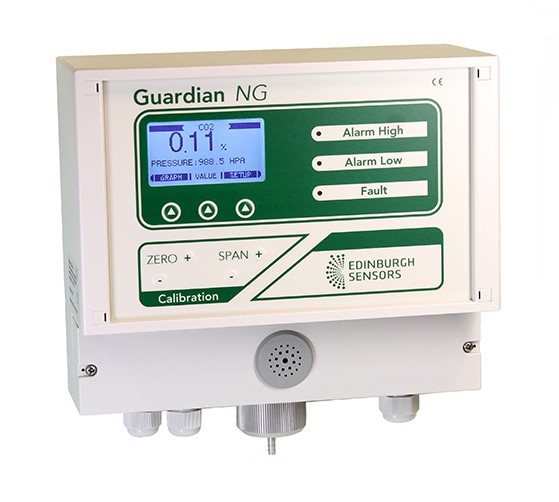With the global COVID-19 pandemic continuing, indoor air quality remains a topic of intense discussion. Since airborne transmission of COVID-19 became a known infection route, experts worldwide have been working on approaches to minimise the risk of indoor viral spread that can potentially be exacerbated by heating ventilation and air conditioning (HVAC) systems.1 This is because the virus can persist on respiratory droplets or aerosols that can either be transported to different areas by air currents and survive in environments with insufficient air refresh rates.
Many large buildings, from offices to schools and hospitals, make use of centralised HVAC systems. This means that the majority of the key infrastructure can be housed in a single, localised area, making for easier maintenance and monitoring.2 At present, most large HVAC systems have some type of monitoring system, both as a way of checking environmental conditions like temperature but also for monitoring air quality.
Maintaining good air quality is important for building and environmental health. As well as being implicated in reducing employee productivity, poor indoor air quality can often be used as an indicator for a working environment with a high risk of airborne COVID-19 spread. For indoor environments, the World Health Organization (WHO) recommends regular exchanges of up to six times an hour, depending on room size and occupancy, as a way of reducing indoor COVID-19 transmission risks.3,4
For sealed buildings, air exchange can only be performed by the HVAC system. If no air exchange occurs in a room, carbon dioxide levels will rise at a rate dependent on the occupancy of the room. Therefore, carbon dioxide levels are often used as a proxy of ‘building health’, with excess carbon dioxide levels being considered one of the signs of poor air quality.5 A very recent study, still awaiting peer review, has shown that carbon dioxide levels are also a good proxy for COVID-19 infection risk in an area.6

Image Credit: SmartPhotoLab/Shutterstock.com
Gas Monitoring for Building Health
Gas monitoring devices are an essential part of creating responsive, active HVAC systems that can offer up to 19 percent cost efficiency savings due to their enhanced energy efficiency.7 They can be used to check for leaks of gases such as carbon monoxide for safety purposes and to assess carbon dioxide levels as a means of monitoring air quality. This is important for not just minimising COVID-19 transmission, but also as a means of avoiding ‘Sick Building Syndrome,’ which is thought to be related to high carbon dioxide concentrations.8
Current best practice for minimising indoor COVID-19 transmission requires a multi-pronged strategy of reducing building occupancy, encouraging social distancing, and increased ventilation.9 Inclusion of filters in HVAC systems can help, such as MERV 13, as can air cleaners like HEPA, GUV, etc., and ventilation rates should meet those outlined in the ASHRAE 62.1 standards, with air flushes between occupancies.10
Edinburgh Sensors for HVAC Systems
Edinburgh Sensors are internationally recognised as experts in the development and production of gas monitoring devices. Many gas sensors from Edinburgh Sensors are already being used as part of integrated HVAC systems and as part of ‘smart building’ management, owing to their ability to provide accurate, fully online monitoring of gas concentrations.11
Edinburgh Sensors offer a range of nondispersive infrared (NDIR) based gas sensors for carbon dioxide monitoring. Molecules such as carbon dioxide absorb infrared light very strongly, and so NDIR sensors can detect even very small concentrations of such gases. This is why two of Edinburgh Sensors’ most popular OEM sensors for carbon dioxide detection, the Gascard NG12, and Guardian NG13, can detect concentrations in the range of 0 – 100 %.
Real-time data collection and monitoring is key for ensuring good air quality and reducing COVID-19 transmission risk and so all of Edinburgh Sensors’ monitors offer several options for integration into HVAC control networks. The Gascard NG has an onboard R232 connection as well as options for TCIP/IP communications protocol. The sensor comes with free data logging software that simply requires an additional cable to connect the sensor to the computer.
Accurate, Reliable Measurements
The Guardian NG offers excellent measurement accuracy of ±2% and zero stability, which is ±2% of the range (over 12 months). The sensor also boasts a range of onboard corrections that allow for true volume % readout over a wide range of pressures, temperature compensation up to 45°C, and humidity conditions of 0 – 95 %.

The Guardian NG has an excellent detection range of 30 m and is an easy-to-install wall-mounted device. The IP54-rated enclosure protects the sensor from dust and water ingress. While it is possible to interface the Guardian NG with external logging systems, the device comes with an interface that can be used to directly view historical readings as well as a built-in alarm system that can be programmed to alert building occupants when carbon dioxide levels exceed a given value.
Edinburgh Sensors can provide extensive technical advice and support on the best gas monitoring solution for your existing HVAC systems and how to best integrate them for optimal measurements of indoor air quality.
References and Further Reading
- Vranay, F., Pirsel, L., Kacik, R., & Vranayova, Z. (2020). Adaptation of HVAC Systems to Reduce the Spread of COVID-19 in Buildings. Sustainability, 12(23), 9992. https://doi.org/10.3390/su12239992
- Centralized HVAC, CED Engineering (2009), http://www.seedengr.com/Cent%20Vs%20Decent%20AC%20Systems.pdf, accessed 20th December 2020
- Zhu, S., Jenkins, S., Addo, K., Heidarinejad, M., Romo, S. A., Layne, A., … Srebric, J. (2020). Ventilation and laboratory confirmed acute respiratory infection (ARI) rates in college residence halls in College Park, Maryland. Environment International, 137(January). https://doi.org/10.1016/j.envint.2020.105537
- COVID-19 Ventilation, World Health Organization (2020) https://www.who.int/news-room/q-a-detail/coronavirus-disease-covid-19-ventilation-and-air-conditioning-in-public-spaces-and-buildings
- Bhattacharya, S., Sridevi, S., & Pitchiah, R. (2012). Indoor Air Quality Monitoring using Wireless Sensor Network. Sixth International Conference on Sensing Technology, 422–427.
- Peng, Z., & Jimenez, J. L. (2020). Exhaled CO2 as COVID-19 infection risk proxy for different indoor environments and activities. MedRxiv, 2020.09.09.20191676.
- US Department of Energy, Pacific Northwest National Laboratory Results (2020) https://buildingretuning.pnnl.gov/publications/PNNL-25985.pdf, accessed 20th December 2020
- HSE on SBS, Health and Safety Executive (2020) http://www.hse.gov.uk/pubns/priced/hsg132.pdf, accessed 20th December 2020
- ASHRAE COVID-19 Mitigation Strategy, W. Bahnfleth (2020), https://enverid.com/watch-dr-william-bahnfleth-ashraes-covid-19-mitigation-recommendations-for-hvac-systems/, accessed 20th December 2020
- HVAC Standards, ASHRAE (2020), https://www.ashrae.org/technical-resources/bookstore/standards-62-1-62-2, accessed 20th December 2020
- About Us, Edinburgh Sensors (2020), https://edinburghsensors.com/about/about-us/, accessed 20th December 2020
- Gascard NG, Edinburgh Sensors (2020) https://edinburghsensors.com/products/oem-co2-sensor/gascard-ng/, accessed 20th December 2020
- Guardian NG, Edinburgh Sensors (2020) https://edinburghsensors.com/products/gas-monitors/gas-monitor-guardian-ng/, accessed 20th December 2020

